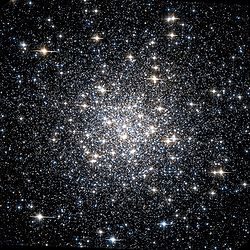| Messier 56 | |
|---|---|
 Messier 56 by Hubble Space Telescope. 3.6′ view | |
| Observation data (J2000 epoch) | |
| Class | X[1] |
| Constellation | Lyra |
| Right ascension | 19h 16m 35.57s[2] |
| Declination | +30° 11′ 00.5″[2] |
| Distance | 32.9 kly (10.1 kpc)[3] |
| Apparent magnitude (V) | 8.3[4] |
| Apparent dimensions (V) | 8.8'[4] |
| Physical characteristics | |
| Mass | 2.30×105[5] M☉ |
| Radius | 42 ly[6] |
| Metallicity | = –2.00[7] dex |
| Estimated age | 13.70 Gyr[7] |
| Other designations | M56, NGC 6779, GCl 110, C 1914+300[8] |
Messier 56 (also known as M56 or NGC 6779) is a globular cluster in the constellation Lyra.[a] It was discovered by Charles Messier in 1779.[b] It is angularly found about midway between Albireo (Beta (β) Cygni) and Sulafat (Gamma (γ) Lyrae). In a good night sky it is tricky to find with large (50–80 mm) binoculars, appearing as a slightly fuzzy star.[9] The cluster can be resolved using a telescope with an aperture of 8 in (20 cm) or larger.[10]
M56 is about 32,900 light-years away from Earth[3] and measures roughly 84 light-years across, containing 230,000[5] solar masses (M☉). It is about 31–32 kly (9.5–9.8 kpc) from the Galactic Center and 4.8 kly (1.5 kpc) above the galactic plane.[11] This cluster has an estimated age of 13.70 billion years and is following a retrograde orbit through the Milky Way. The properties of this cluster suggest that it may have been acquired during the merger of a dwarf galaxy, of which Omega Centauri forms the surviving nucleus. For Messier 56, the abundance of elements other than hydrogen and helium, what astronomers term the metallicity, has a very low value of [Fe/H] = –2.00 dex which is 1⁄100 of the abundance in the Sun.[7]
The brightest stars in M56 are of 13th magnitude, while it contains only about a dozen known variable stars, such as V6 (RV Tauri star; period: 90 days) or V1 (Cepheid: 1.510 days);[12] other variable stars are V2 (irregular) and V3 (semiregular). In 2000, a diffuse X-ray emission was tentatively identified coming from the vicinity of the cluster. This is most likely interstellar medium that has been heated by the passage of the cluster through the galactic halo. The relative velocity of the cluster is about 177 km s−1, which is sufficient to heat the medium in its wake to a temperature of 940,000 K.[13]
M56 is part of the Gaia Sausage, the hypothesised remains of a merged dwarf galaxy.[14]
- ^ Cite error: The named reference
hcob849_11was invoked but never defined (see the help page). - ^ a b Cite error: The named reference
aj140_6_1830was invoked but never defined (see the help page). - ^ a b Cite error: The named reference
arXiv2118was invoked but never defined (see the help page). - ^ a b "Messier 56". SEDS Messier Catalog. Retrieved 29 April 2022.
- ^ a b Cite error: The named reference
apj742_1_51was invoked but never defined (see the help page). - ^ From trigonometry: radius = distance × sin( diameter_angle / 2 ) = 32,900 × sin(8.8′/2) = 42.1 ly.
- ^ a b c Cite error: The named reference
mnras404_3_1203was invoked but never defined (see the help page). - ^ Cite error: The named reference
simbadwas invoked but never defined (see the help page). - ^ Cite error: The named reference
thompson2007was invoked but never defined (see the help page). - ^ Cite error: The named reference
inglis2004was invoked but never defined (see the help page). - ^ Cite error: The named reference
aaa450_1_105was invoked but never defined (see the help page). - ^ Cite error: The named reference
aa58_121was invoked but never defined (see the help page). - ^ Cite error: The named reference
mnras316_1_L5was invoked but never defined (see the help page). - ^ Myeong, G. C; Evans, N. W; Belokurov, V; Sanders, J. L; Koposov, S. E (2018). "The Sausage Globular Clusters". The Astrophysical Journal. 863 (2): L28. arXiv:1805.00453. Bibcode:2018ApJ...863L..28M. doi:10.3847/2041-8213/aad7f7. S2CID 67791285.
Cite error: There are <ref group=lower-alpha> tags or {{efn}} templates on this page, but the references will not show without a {{reflist|group=lower-alpha}} template or {{notelist}} template (see the help page).
![{\displaystyle {\begin{smallmatrix}\left[{\ce {Fe}}/{\ce {H}}\right]\end{smallmatrix}}}](https://wikimedia.org/api/rest_v1/media/math/render/svg/4c0821bd80891e071c08e7c7ee8e022baedf522c)